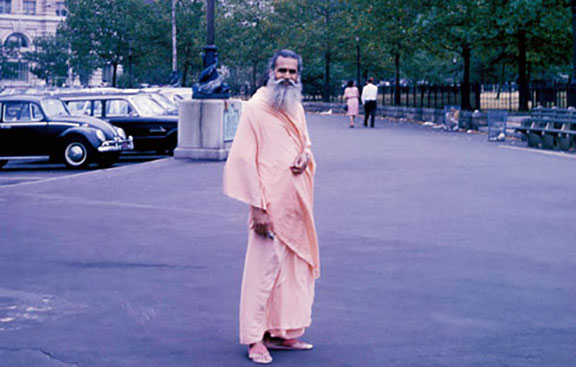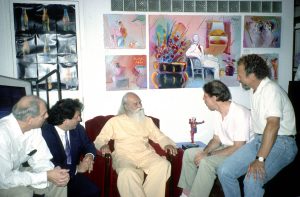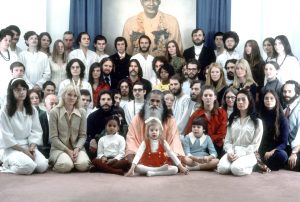 It was in July 1966, that pop artist icon Peter Max (spiritual name, Atman) invited Sri Gurudev Swami Satchidananda (known as “Swamiji” at that time) to the United States. Sri Gurudev had been invited to Europe a few months earlier by filmmaker Conrad Rooks (who made the film “Herman Hesse’s Siddhartha”) who had met Sri Gurudev in Sri Lanka (then Ceylon). Conrad began studying Yoga with Sri Gurudev and then asked him to be in Conrad’s first film, Chappaqua, which also included sitar impresario Ravi Shankar, poet Allen Ginsberg, among other 60s luminaries. Peter Max hosted Sri Gurudev’s first visit to America where he stayed with Peter’s close friend Victor Zurbel (spiritual name, Arjuna). Arjuna served as the first President of the New York IYI. In this article, he shares his memories of those first days and weeks of Gurudev’s arrival in the USA.
It was in July 1966, that pop artist icon Peter Max (spiritual name, Atman) invited Sri Gurudev Swami Satchidananda (known as “Swamiji” at that time) to the United States. Sri Gurudev had been invited to Europe a few months earlier by filmmaker Conrad Rooks (who made the film “Herman Hesse’s Siddhartha”) who had met Sri Gurudev in Sri Lanka (then Ceylon). Conrad began studying Yoga with Sri Gurudev and then asked him to be in Conrad’s first film, Chappaqua, which also included sitar impresario Ravi Shankar, poet Allen Ginsberg, among other 60s luminaries. Peter Max hosted Sri Gurudev’s first visit to America where he stayed with Peter’s close friend Victor Zurbel (spiritual name, Arjuna). Arjuna served as the first President of the New York IYI. In this article, he shares his memories of those first days and weeks of Gurudev’s arrival in the USA.
It was 1966 and I decided that the drug experience I had just come out of was going to be my last. Not because it was a bad trip, but because it was a good one. Good in the sense that I had certain visions in a higher state of consciousness, and in returning to my normal state I was able to see that there were many obstacles I had placed in the path toward my self—one of which were the chemicals I was taking to get there.
I realized that I was really getting no closer each time, because the drug only catapulted me forward and then brought me back to the same place I was before—leaving me dependent on it to get me there. I discovered that I really wanted to find a way of getting rid of all the unwanted elements in between, because even in taking drugs I was doing it with a sincerity of purpose. I really wanted to find the source of all joy and peace. And I somehow felt that there must be a better way of getting there. But what it was I had no idea.
It was then that my friend Peter Max, who was having a similar experience, called me up to invite me over to visit a Swami who had just arrived in New York. Well, if a “Swami” still sounds strange to some people today, you can imagine what it seemed like in 1966. This was before the Beatles were involved with the Maharishi. There was just no exposure. So there I was in Peter’s apartment, legs crossed, puffing on a cigarette, throwing questions at a Swami. As soon as I got back home, Peter called me.
“Well, what do you think?”
“Interesting guy,” I said. I was still trying to digest what and who he was.
“Do you want to help me find an apartment here, where we could set him up and take classes?” Peter asked.
I tried to remain non-committal, but Peter managed to persuade me, so we began to search for an apartment. Then, out of the blue, a guy came forward and offered his apartment for free. The only catch was that it was in the worst shape I had ever seen any apartment in New York. I vetoed it immediately. But, once again, Peter convinced me: we should take it and fix it up. That weekend. So, even though I was just about to go away on a long-needed vacation, I cancelled my weekend plans.
But there was still a problem: to get that place in order over the weekend would take a small army, and so far all we had were ourselves; almost everybody we knew was going away for the weekend. Besides, how do you get a group of people in New York to fix up an apartment for someone they have never met or even heard of, with no renumeration of any sort? Impossible.
A Lesson in Karma Yoga
By Friday afternoon, the only person I had managed to get to help was my girlfriend Runa. But Peter had said a friend of his would come, and he was determined to go ahead. When we got to the apartment Friday night, there were about a dozen people waiting—all strangers to each other, ready to go to work to fix up a place for another stranger. It seemed that Peter’s friend brought a friend who brought another friend, etc. So no one person knew more than two or three other people in the room. And nobody, myself included, knew why we were there and what we were doing. We just did it.
At the end of the weekend we were all exhausted, but we had a spotless, beautiful apartment. Then the owner, who had been away all this time, walked in.
“What did you do? You ruined my apartment,” he cried.
Despite the beautiful job we had done, he said he preferred the way it had been, as it was a good atmosphere for getting high, sex orgies, etc. And there was another misunderstanding—he said we were free to use the apartment during the week, but that he crashed there on the weekend.
Well, you can imagine how we felt. And just then, in walked the Swami, whom none of these people had met yet. He introduced himself, and sensing something was wrong, inquired about what the problem was. We told him about the situation and Swamiji thought it would be best to leave it and look for another place.
“Oh, no,” one of us groaned. “You mean all this work was for nothing?”
Swamiji slowly and calmly looked at each of us, while he was taking stock of the situation. “Are you people all belonging to a club or group of some sort?” he inquired.
“No.”
“Then are you all attending the same college or university?”
” No.”
“Hmmm. Do you all live in the same building or share the same house?”
“No.”
“What I am wondering is, how all you people came together to do all this wonderful work? Are you not all friends?”
“We are now, Swami,” someone answered him, “but when we started, we were all strangers.”
“So you were all strangers before this weekend and now you are a large group of friends. Who said ‘all this work was for nothing’ then?”
Then we looked at each other and we all felt that the work was certainly not for nothing.
Swamiji then added, “In the East we call such work Karma Yoga. Work without expectation of reward. It is a wonderful practice.” I was gradually beginning to get an idea of who Swamiji was.
At this point Runa whispered in my ear that I should invite Swamiji to stay at my apartment, and Swamiji, after making sure that it would in no way be an inconvenience, accepted.

Parks and Museums Inside
(photo left-right: Sri Swamiji, Peter Max and Victor Zurbel, at the Peter Max Studio, NYC, 1990s)
Swamiji arrived the next morning. It was then that I found out for sure who he was and what our relationship was going to be. I was very busy with work and had very little time to be with him during the day, so I told him of all the places nearby he could visit by himself. “The Museum of Natural History is one block away, the American Historical Society is on the corner and Central Park is just across the street.”
He warmly replied that he had been traveling around the world and would be quite content just to stay inside. I felt he was a little unsure about traveling by himself, so I offered to break away at lunch time and escort him to the museums and park. It was a beautiful day. But he looked into my eyes with warmth and said, “I will really be quite happy to stay inside. I have many parks and museums within me.”
What happened then is difficult to put into words. I felt that I too wanted to discover the parks and museums within myself. I didn’t know it at the time, but I had just accepted Swamiji as my Guru. Tears of joy streamed down my cheeks as I bid Swamiji a good day and took off for my office. Incidentally, it was one of the most productive days of my career. I was an art director and was putting together a supplement on the state of Arizona for The New York Times. To this day it is one of my best pieces of work. You can see the Yoga influence in it.
Further Lessons in Yoga
I had warned Swamiji that I would be home very late that night. I had a large bedroom with two beds and offered Swamiji the large one and took the little one for myself. I came home at about three in the morning, quietly took off my shoes and changed into my pajamas, and tip-toed into the bedroom. There, to my wonder, was Swamiji lying flat on his back with his palms up, looking like a corpse (he was actually in savasana, the corpse pose).
I got into bed and then realized that I had to be up at seven, but the alarm clock was on the table next to Swamiji’s bed and the outlet was underneath his bed. Resigning myself to the fact that I was not about to go crawling under his bed at three in the morning, I went to sleep. But I didn’t go right to sleep. First I turned this way, then that way. Then I put my arm under my head, then I turned on my stomach. Swamiji’s stillness, however, was making me very aware of my own movements, to the point that I felt like an animal next to him. So I just rolled over on my back, put my hands alongside my body and went into the most wonderful dreamless sleep I had ever had.
I woke up fully refreshed, looked at. my watch, and saw that it was exactly seven o’clock. Swamiji was not in bed. He was sitting on the living room floor on my Hopi Indian rug, had some incense burning, and was meditating. I went into the bathroom to shower and shave and when I came out Swamiji was holding a coffee mug, offering it to me to drink. I drank the delicious drink and asked him what it was.
“Hot milk with honey. Don’t you drink it?” he asked.
“I used to when I was sick as a child.”
“You should drink it when you are well, not when you are sick,” he said smiling. And then he added, “I saw you come in so quietly last night, as not to disturb me. Very nice of you.”
“But Swamiji, if you saw me come in, then I must have disturbed you.”
“No disturbance,” he reassured me. “If the mind is restful during the day, it does not even need sleep. I just rest the body, and put the mind away, sort of like putting it in a drawer. If I need it, I take it out, and then gently put it back again.”
The little things that happened in the weeks that followed could fill the pages of a whole book. But I’ll just say that I had the extraordinary privilege of having Swamiji’s acquaintance as a friend, only slowly discovering the depth and magnitude of his being. So everything I was learning was by the way of gentle example. How to move chairs, close doors, sleep, eat, etc. Before Swamiji moved in, my apartment was a storehouse for antiques and old junk. And when he left and moved over to the Oliver Cromwell Hotel two weeks later, it was spotless, the walls were clear.
“Is there anything I can do for you?” I would ask him.
“Everything is quite fine. It is a wonderful apartment. But if I could ask a little favor, there is a terrible face with a tongue sticking out at me when I wake up in the morning.”
I quickly took down the Mexican devil mask on the wall opposite his bed. And I began to see that all the objects I had collected had a certain vibration to them that I wasn’t aware of before and that they only helped to clutter my place up. And while I was un-cluttering my apartment, I noticed that my mind was getting uncluttered at the same time.
The Rest is History
 (Photo: Members of the first Integral Yoga Institute of New York with Swami Satchidananda, in front of a portrait of his master, Sri Swami Sivananda, circa 1968).
(Photo: Members of the first Integral Yoga Institute of New York with Swami Satchidananda, in front of a portrait of his master, Sri Swami Sivananda, circa 1968).
In my apartment those first two weeks, about 10 to 25 people would come each evening for casual lectures, and when we moved to the Oliver Cromwell Hotel only two weeks later, there were 25 to 50. And that was where Swamiji started to teach Hatha Yoga. He gave the classes himself and soon the proficient students began teaching. Then it grew larger, we incorporated the Integral Yoga Institute and moved over to 500 West End Avenue. The rest is history.
There were many opportunities in those early days to obtain notoriety on TV and in the press, but Swamiji wisely steered away, anticipating wrong exploitation. The Integral Yoga Institute grew like a tree. Swamiji nurtured it like a gardener, checking the condition of the soil, replanting it with care every time it grew too big for the pot, snipping off the top a little so some nice branches could come out, and when the time was right, letting it take root in a beautiful building on West 13th Street.
As for our personal history, Aruna and I were married by Swamiji on June 30th, 1968, and in August we took our honeymoon traveling with him and other members of the IYI. That two-and-a-half month trip allowed us to share some truly wonderful moments with Swamiji. Om Shanti.
About the Author:
Victor Arjuna Zurbel has been at the forefront of the holistic health, spiritual, and new age movements since the mid 1960s and has been instrumental in helping Yoga take firm roots in America. In 1966 he was introduced to Swami Satchidananda by artist Peter Max and became a founder and the first president of the Integral Yoga Institute. Zurbel is a former award-winning Art Director and Copywriter for major New York advertising agencies, including the legendary Doyle Dane Bernbach. In 1986, he became senior art director and writer at world- renowned artist Peter Max’s New York atelier. Zurbel’s editorial writings include award-winning supplements for the Sunday New York Times and numerous feature articles for consumer, health and Yoga magazines. Zurbel has written two vegetarian cookbooks: The Vegetarian Family (Prentice Hall, 1978) and The Natural Lunchbox (Holt Rinehart, 1986).

